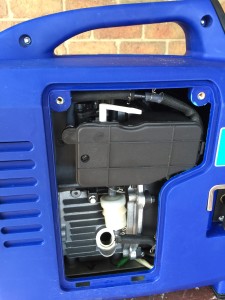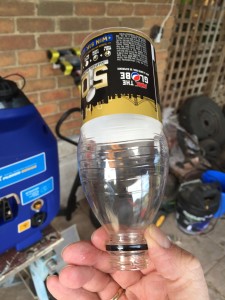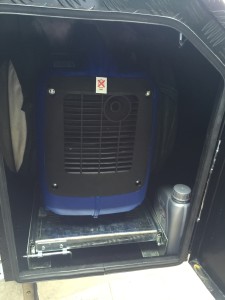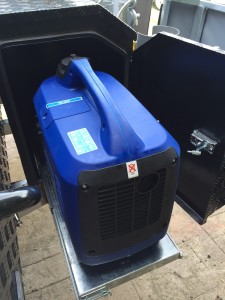Long Term Test – Cheap Chinese Generator
 Ok. I’m going to enter uncharted territory. I’m going to start a sort of mini blog about our new X-Plorer Series G2500 Digital Inverter Generator. Its basically a cheap Chinese 2.5 KVA inverter generator similar to what you can buy on eBay for around the $500 to $800 price point depending on which country it is shipped from. We got this generator as part of the deal with our new Roadstar Safari Tamer caravan. When they said they would include a generator in the final price, for some reason I didn’t give it a second thought and never asked what they intended to supply. So now we have it and are pretty much stuck with it. Not as though that’s a bad thing, but I already had a generator and really wasn’t wanting another one.
Ok. I’m going to enter uncharted territory. I’m going to start a sort of mini blog about our new X-Plorer Series G2500 Digital Inverter Generator. Its basically a cheap Chinese 2.5 KVA inverter generator similar to what you can buy on eBay for around the $500 to $800 price point depending on which country it is shipped from. We got this generator as part of the deal with our new Roadstar Safari Tamer caravan. When they said they would include a generator in the final price, for some reason I didn’t give it a second thought and never asked what they intended to supply. So now we have it and are pretty much stuck with it. Not as though that’s a bad thing, but I already had a generator and really wasn’t wanting another one.
 As it turned out, the generator we originally had, a Fuji 4.4 KVA eBay special, wouldn’t fit into the special generator storage box on the Safari Tamer’s drawbar. Its just a bit too tall. The X-Plorer fits perfectly.
As it turned out, the generator we originally had, a Fuji 4.4 KVA eBay special, wouldn’t fit into the special generator storage box on the Safari Tamer’s drawbar. Its just a bit too tall. The X-Plorer fits perfectly.
I would have preferred to maintain the 4.4KVA capacity of the Fuji but at 2.5KVA should be sufficient to run the 240v equipment we need. More on that later.
Now 2.5 KVA translates to 2,000 watts capacity on this particular generator. That’s because, like most generators, its power factor is 0.8. So 2,500VA x 0.8 power factor = 2,000 watts. That is peak power output. The nominal or continuous rated output, what it can sustain for an extended period, is actually 1,700 watts. The Ibis Air Command 3 air conditioner on the Safari Tamer is rated at 1,392 watts so technically, it should run from the X-Plorer without too much effort.
Removing the X-Plorer out of the box and lifting the unit onto the workbench its immediately apparent that this is a pretty solidly built piece of kit. The plastic casing and handle are quite sturdy and give the impression they can cope with fairly rough use. And while its relatively heavy at about 19kgs, its about 6kg lighter than the Fuji unit we had that gave me a hernia every time I took it out of the front boot of the old van. Its also 2 kgs lighter than the Honda EU20i, which is the popular choice for caravanners. So far so good.
Its pretty clearly marked with all functions and warnings clearly readable.
 Before starting the generator, you need to put oil in it. To do this you need to remove the side panel
Before starting the generator, you need to put oil in it. To do this you need to remove the side panel  to expose the oil tank filler. A Phillips screwdriver is all that’s required to remove the 2 screws holding the cover in place. The filler is quite low in the unit and you will need a funnel to fill it without spilling oil everywhere. I didn’t have one handy so I used a small plastic drink bottle with the bottom cut off. Worked a treat. The oil reservoir takes about 0.5 litres of oil. Check to ensure you have the correct grade of oil as they do differ slightly between brands.
to expose the oil tank filler. A Phillips screwdriver is all that’s required to remove the 2 screws holding the cover in place. The filler is quite low in the unit and you will need a funnel to fill it without spilling oil everywhere. I didn’t have one handy so I used a small plastic drink bottle with the bottom cut off. Worked a treat. The oil reservoir takes about 0.5 litres of oil. Check to ensure you have the correct grade of oil as they do differ slightly between brands.
Once filled with oil, its time to fill the fuel tank. I noticed the X-Plorer doesn’t have a fuel cap like other generators in that it doesn’t have a vapour valve. Instead it has a cap similar to that of your motor vehicle that simply twists shut and clicks when tight. There’s a pretty good filter in the filler neck to catch any dirt and debris in the fuel and its easily removable for cleaning.
Once fuelled up, you have to prime this generator via the rubber bulb on the side panel. I’m not a fan of this design as the bulb is vulnerable to damage and they have been known to perish. That said, this one feels like its made from very thick material so, with care, this shouldn’t be a problem.
With the choke engaged the unit didn’t start straight away. The pull start also felt a bit stiff. But after opening the choke, it started with one more pull of the starter cord. There’s a certain satisfaction hearing the engine come to life for the first time.
 For noise, it doesn’t appear to be too bad however I was firing it up in my carport so I will need to do a proper
For noise, it doesn’t appear to be too bad however I was firing it up in my carport so I will need to do a proper outdoor sound test to see how loud it really is.
outdoor sound test to see how loud it really is.
To test it out I tried 2 power tools. First was a small 700 watt electric jig saw. The X-Plorer powered this without any issues. Next was a larger 1200 watt circular saw. Again it powered this without any problems at all.
So for now I’m pretty happy. The X-Plorer is light weight for a generator, fits into the storage box of the van, is not too noisy and appears to have sufficient power to cope with the main requirements of a caravan.
Next test will be to hook it up to the van and try powering various appliances including the air conditioner and battery charger. Stay tuned for the next report.
| Make | Model | KVA Rating | Power factor | Peak power watts | Nominal Power watts | Weight KGs | Fuel capacity Litres | Approx price online |
| X-Plorer | G2500 | 2500 | 0.8 | 2000 | 1700 | 19 | 3.5 | unknown |
| Honda | EU20i | 2000 | 1.0 | 2000 | 1600 | 20.7 | 3.6 | $2,000 |
| Fuji Micro | F5200i | 2700 | 1.0* | 2700 | 2500 | 29 | 5.0 | $600 |
| Yamaha | EF2000iS | 2000 | 1.0* | 2000 | 1600 | 20 | 4.4 | $1,650 |
| GenTrax | 2015 – 2KVA | 2000 | 1.0* | 2000 | 1700 | 18.5 | 4.5 | $440 |
* Estimated power factor based on power rating. True figure not quoted in specifications.
Update 16 December 2015 – Ultimate Power Test.
Last night I finally got the oportunity to test out the generator running what I would consider its highest load requirements. That is running the air conditioner and the battery charger simultaniously. I’m pleased to report that the test was a complete success.
The air conditioner is an Ibis Air Command 3 which, according to the specifications, draws 5.8 amps while cooling (strangely it draws only 5.5 amps while heating). At 240v that’s 1,392 watts. The battery charger is a cTek MXS 25 rated at 2.9 amps (240v) at maximum charge output, or 696 watts. Running these 2 together is a combined total of 8.7 amps or 2,088 watts which is actually over the generator’s maximum output. In reality, these maximum figures are not likely to be experienced for very long periods of time and I expect the average current draw would be a fair bit less. Now I would not likely ever need to run the two together in the real world however doing so on this occasion would be a very good test of the generator’s cababilities.
After starting the generator, I connected it to the van using the standard 15 amp lead. The generator’s 240v output socket is a 15 amp plug. I ran it like this with no load for a short time to ensure the RCD switches didn’t trip. Then I switched the air conditioner on. You could hear the generator revs increase with the load but not to an alarming extent. I left it running for about 10 minutes like this with no issues. Then I switched on the battery chager. It goes through its full sequence of charging stages varying the output. There was no change to the generator’s revs. It basically took all this load in its stride. I left it running like this for another 10 minutes. I then repeated the startup process for the sheer benefit of recording a video of the generator doing its job.
After this, I took some sound level meter readings to see just how loud the unit is when under full load. Standing right next to the generator, I recorded 58.8db which is comparable to a Honda of the same capacity. Next I took a reading from across the street, a distance of about 15 metres, where it recorded 43.5db. Considering this is a cheap generator, those figures are awesome.
So to sum up, the generator has exceeded my expectations. It will easily run any individual load in the van and is capable of running the maximum load we would ever likely need it to do. Reliability and longevity are the only unknowns at this stage. Right now I’m very happy with it.

